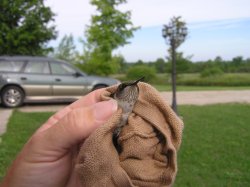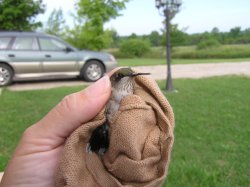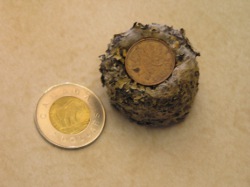Ruby-throated Hummingbird
(Archilochus colubris)


Description
The adult male is easy to identify in good light with his spectacular ruby red gorget (throat) and emerald green back. His tail is entirely green and has a deep V-shaped notch. The male is smaller than the female with a shorter bill.
The adult female has an emerald green back with a white throat and breast. Her tail is shorter than the male and more rounded with white tips.
Immature males and females are almost identical to the adult female and very difficult to tell apart except when the young male is starting to grow gorget feathers.
Breeding
The Ruby-throated Hummingbird is the only hummingbird known to breed in Eastern Canada. Anna's, Rufous, Calliope and Black-chinned breed from the Rockies west to the Pacific coast. Female hummingbirds do all the work when it comes to raising a family. The male does not help beyond fertilizing the eggs. The female builds the nest, feeds and cares for the nestlings.
Hummingbirds nest in both deciduous and coniferous trees, usually about 20 feet from the ground but nests have been found in small shrubs, on christmas tree lights, and other unusual places between 5 and 50 feet high. The nest is made of thistle or dandelion down and the female attaches lichens to the outside with spider webs to make it virtually invisible. The entire nest will fit on a "Toonie" and is about an inch high. A penny will not quite fit inside.
The female lays 2 white eggs that are each about the size of a pea. It takes 12-14 days for the eggs to hatch and the nestlings don't look much like hummingbirds with their short, stubby bill. They stay in the nest for about 3 weeks while the female brings them a steady diet of insects.

Status and Conservation
The number of Ruby-throated Hummingbirds in Canada is difficult to estimate and more study is needed. Banding studies in the United States have shown that male hummingbirds live at least 7 years and females up to 9 years. Natural predators that kill hummingbirds include shrikes and Sharp-skinned Hawks. Rarely Blue Jays or other species of bird, frogs, praying mantises, fish and spider have been observed capturing and eating hummingbirds. Hummingbirds sometimes die after becoming trapped by the sticky seed heads of burdock (an introduced species from Europe). Unnatural causes of death include collisions with windows, cars, communication towers, pesticide use, and predation by domestic cats.
You can help by counting the number of hummingbirds coming to your feeder each day or by agreeing to be a hummingbird research site where your hummingbirds can be banded and recaptured year after year to see how long they live. Banding is the only way to identify and determine the actual age of an individual hummingbird.